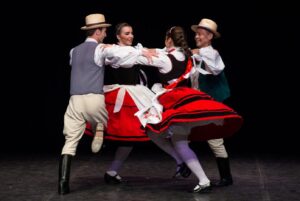Timár Dance Ensemble
Sándor Timár (94) has been one of the most prominent figures in the field of Hungarian folk dance and choreography during the latter half of the 20th century. He has been a leading proponent of the so-called new folklorism movement, in the context of which he fundamentally redefined traditional notions of Hungarian folk dance.
Inspired primarily by Béla Bartók’s oeuvre, his art is characterized by the staging of folk dance in its pure and authentic form, complemented by the structural and stylistic elements of classical European art music.
Since 1979, Sándor Timár, his wife, Böske Timár, and their family have been countinuously invited year by year to Japanese universities to teach Hungarian folk dance. Over the past 46 years, thousands of dancers across Japan have had the opportunity to master Hungarian folk dance culture thanks to the unique Timár Method. Sándor Timár’s work has been recognized multiple times by the Emperor of Japan. At the personal invitation of the Japanese imperial couple, the dance ensemble founded by Sándor Timár had also the privilege to perform at the Imperial Palace in Tokyo.
The Timár Ensemble was established with the objective of showcasing the body of work and artistic philosophy of Sándor Timár from a multitude of perspectives. Their goal is to present the Master’s oeuvre through the lens of young dancers of the 2020s, offering audiences a deeper understanding of his legacy and his vision of folk dance.




